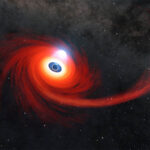NASA Gets Unusually Close Glimpse of Black Hole Snacking on Star
Multiple NASA telescopes recently observed a massive black hole tearing apart an unlucky star that wandered too close. Located about 250 million light-years from Earth in the center of another galaxy, it was the fifth-closest example of a black hole destroying a star ever observed. A disk of hot gas…
ESPRESSO and CARMENES discover two potentially habitable exo-Earths around a star near the Sun
An international scientific team led by researchers at the Instituto de Astrofísica de Canarias (IAC) has discovered the presence of two planets with Earth-like masses in orbit around the star GJ 1002, a red dwarf not far from the Solar System. Both planets are in the habitability zone of the…
Gamma-ray Bursting with Surprises
For the first time, astronomers found surprising clues of a ‘kilonova’ – a huge explosion sparked by the clash of neutron stars when studying the “post-credits-scene” of a long gamma-ray burst. But what makes this kilonova discovery surprising? How did two different teams of astronomers discover the same surprising results? Let’s explore! This artist's…
NASA’s Webb Reveals an Exoplanet Atmosphere as Never Seen Before
NASA’s James Webb Space Telescope just scored another first: a molecular and chemical profile of a distant world’s skies. While Webb and other space telescopes, including NASA’s Hubble and Spitzer, previously have revealed isolated ingredients of this broiling planet’s atmosphere, the new readings from Webb provide a full menu of…
NASA’s Webb Catches Fiery Hourglass as New Star Forms
NASA’s James Webb Space Telescope has revealed the once-hidden features of the protostar within the dark cloud L1527, providing insight into the beginnings of a new star. These blazing clouds within the Taurus star-forming region are only visible in infrared light, making it an ideal target for Webb’s Near-Infrared Camera…
Gemini North catches a beautiful pax-de-deux
Using the Gemini North telescope in Hawai'i, astronomers have just caught a spectacular image of a cosmic event around 60 million light-years away from us in the direction of the Virgo constellation. The image is of two spiral galaxies, NGC 4568 and NGC 4567 are in the process of merging…
Solar Orbiter’s unprecedented view of the quiet corona
Versão portuguesa disponível aqui The ESA-led Solar Orbiter mission has experienced its second close encounter with the Sun. It is delivering more stunning data, and at higher resolution than ever before. The moment of closest approach took place on 12 October at 19:12 UTC, when Solar Orbiter was just 29%…
This Universe’s most massive star just said “cheese!”
Located in the Tarantula Nebula at about 160,000 light-years from us, R136a1 is the most massive star we know across the whole Universe. Using the Gemini South telescope in Chile, astronomers recently managed to get the sharpest image ever made of the gigantic star. The image suggests that maybe such…
NASA Confirms DART Mission Impact Changed Asteroid’s Motion in Space
Versão portuguesa disponível aqui Analysis of data obtained over the past two weeks by NASA’s Double Asteroid Redirection Test (DART) investigation team shows the spacecraft's kinetic impact with its target asteroid, Dimorphos, successfully altered the asteroid’s orbit. This marks humanity’s first time purposely changing the motion of a celestial object…
Soapbox Science Lisbon 2022 – Empowering Women in STEM
Soapbox Science comes on October 15th for the third time to Portugal, Lisbon. As a premier we will be found for the first time live in person at FICA Oeiras 🇵🇹 Versão portuguesa disponível aqui Over the last decade large investment in science outreach and promotion of careers in Science,…











